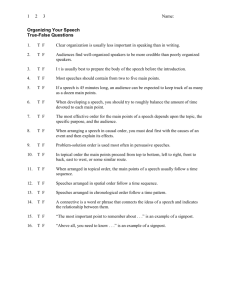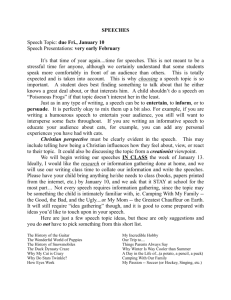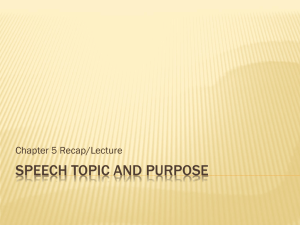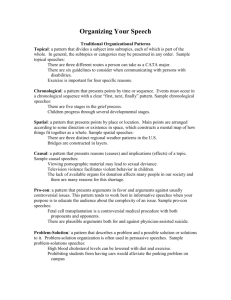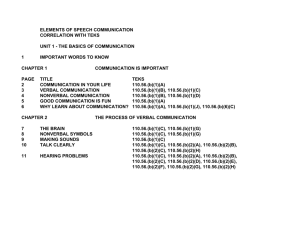A word document - 62 Phantom Squadron
advertisement
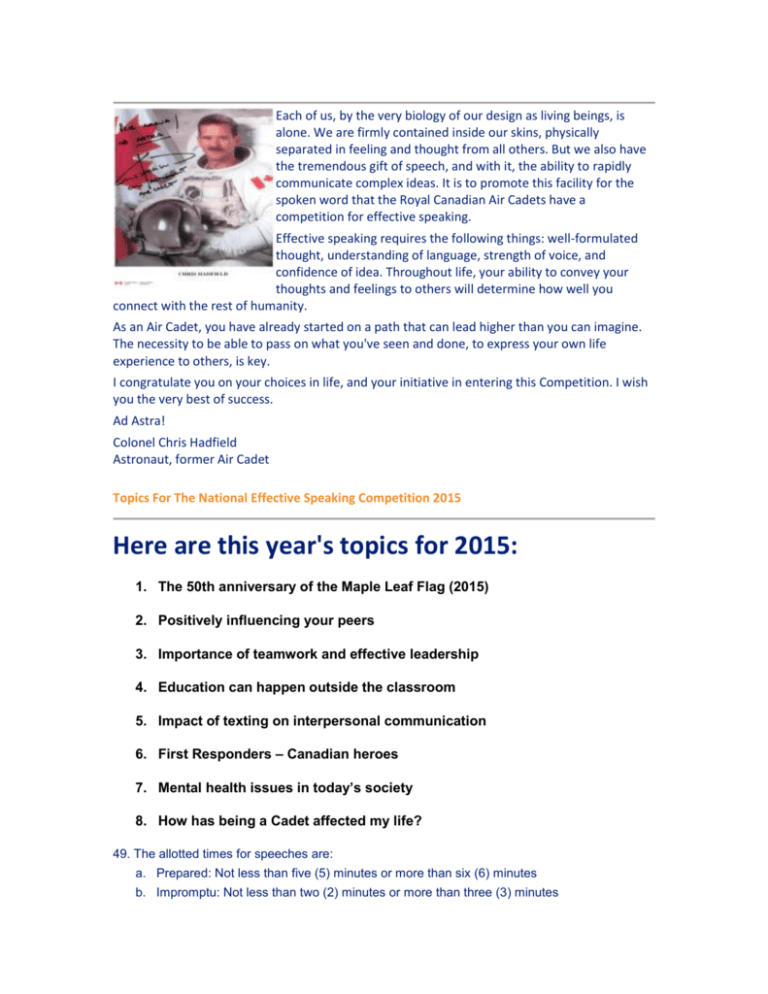
Each of us, by the very biology of our design as living beings, is alone. We are firmly contained inside our skins, physically separated in feeling and thought from all others. But we also have the tremendous gift of speech, and with it, the ability to rapidly communicate complex ideas. It is to promote this facility for the spoken word that the Royal Canadian Air Cadets have a competition for effective speaking. Effective speaking requires the following things: well-formulated thought, understanding of language, strength of voice, and confidence of idea. Throughout life, your ability to convey your thoughts and feelings to others will determine how well you connect with the rest of humanity. As an Air Cadet, you have already started on a path that can lead higher than you can imagine. The necessity to be able to pass on what you've seen and done, to express your own life experience to others, is key. I congratulate you on your choices in life, and your initiative in entering this Competition. I wish you the very best of success. Ad Astra! Colonel Chris Hadfield Astronaut, former Air Cadet Topics For The National Effective Speaking Competition 2015 Here are this year's topics for 2015: 1. The 50th anniversary of the Maple Leaf Flag (2015) 2. Positively influencing your peers 3. Importance of teamwork and effective leadership 4. Education can happen outside the classroom 5. Impact of texting on interpersonal communication 6. First Responders – Canadian heroes 7. Mental health issues in today’s society 8. How has being a Cadet affected my life? 49. The allotted times for speeches are: a. Prepared: Not less than five (5) minutes or more than six (6) minutes b. Impromptu: Not less than two (2) minutes or more than three (3) minutes Aim To provide an opportunity for Air Cadets to increase their self confidence; and increase their ability to reason, organize and express ideas; To promote the citizenship component of local squadron training; To provide a focus at the local, Regional/Wing, Provincial/Territorial, and National levels, to promote and encourage air cadets to participate in an opportunity to acquire effective speaking skills through instruction and practice in a structured and competitive environment; To increase public awareness regarding the citizenship and leadership aspects of the Air Cadet program at the national, provincial and local levels. Contest/Competitions Guide for Speech The following guide to speech will break speech into elements which will be developed as follows: Content- Types of speeches Organization- How should a speech be structured Mechanics- Physical mannerisms associated with speech Style- The speakers impact as a product of humor, spontaneity, language, originality and poise Good Speech- Breathing, posture, neck muscles, lower jaw, lips and tongue exercises. Content Speakers generally have a number of purposes: To inform - by imparting a body of knowledge. To persuade - by trying to convince the audience that the speakers advocacy is desirable. To entertain - by pleasing and amusing the audience. The Speech to Inform Careful preparation is essential - keep your purpose clearly in mind before you commence preparation. Have the needs and background of the audience in mind when you prepare and keep the explanation simple when you deliver the speech. Watch your audience carefully for a reaction. If people are not understanding -- and you can usually tell -- be prepared to slow down, rearrange, simplify, omit or repeat in order to achieve your objective of audience understanding. Do not attempt to give too much information and avoid lengthy use of statistics or other data which is more suitably presented in written rather than oral form. The Speech to Persuade Research your material completely and find evidence, other than your own opinion, to support the points you are making. Rely on reason, logic, and evidence rather than emotion alone to persuade your audience. Find authorities - experts in the field you are discussing who support your point of view. Your concern on all occasions should be "the truth". If you believe in a cause and want to persuade others to agree with you, avoid distortions, misquotations, evidence and quotations taken out of context or anything else which detracts from the honesty and sincerity with which the speech is to be delivered The Speech to Entertain Entertaining speeches require the same detail of preparation as others. One can be humorous and entertaining while still having a serious, worthwhile message. Humor used should be relevant and suited to the audience. You can entertain just as well with a witty choice of words and style of presentation as with a joke. Wit can be used effectively in almost any kind of speech. Be careful with sarcasm, there is a fine line between sarcasm which is humorous and sarcasm which is insulting and/or condescending. Remember! Determine your desired response before you begin. When competing in a speech event, you should: choose a subject that suits you; choose a subject that suits your audience; choose a subject that suits the occasion; choose a subject that suits the time allowance. Organization Generally speaking there are three parts to every speech. The Introduction The Body The Conclusion Before proceeding, some consideration should be given to the issue of originality. Beginner speakers are sometimes instructed that the three parts of a speech should: tell them what you are going to tell them; tell them, then; tell them what you told them. The beginner speaker may find this "prescriptive" approach useful and it must be said that there are instances where this approach can work. There is, however, a danger of formal speech making and lack of originality. Speeches intended to entertain rarely follow this simplistic format. They become very boring if they do. In fact most speeches that follow this format have an element of boredom because they are too predictable, but they can be very instructive, if that is the intention of the speaker. Introduction Your introduction can be used to gain attention, give attention, give a favorable impression of yourself, create the right state of mind in your listeners, lead into the subject, state the central idea or indicate the division to be developed. You may wish to: 1. Explain the terms being used and offer qualification / limitations when needed; 2. Begin with a personal experience designed to identify with the listeners; 3. Ask a question or series of questions; 4. State a relevant quotation; 5. Challenge your audience with a startling statement; 6. Amuse your audience; and 7. Some or all of the above. Body The most important part of the speech is the body. How you structure the body depends on your purpose. Are you trying to entertain, to persuade, or to inform? There are 7 structures which you should consider: 1. Logical or topical; 2. Chronological; 3. Spatial; 4. Classification; 5. Problem - Solution; 6. Cause - Effect; and 7. Combination of the above. The following descriptions are quoted from Getting Started in Public Speaking, by James Payne and Diana Prestice, National Textbook Company, 1985, Lincolnwood. Logical or Topical Order Logical or topical organization is one of the most common patterns. It is especially useful for informative and entertainment speeches. This pattern is used when you have several ideas to present and one idea seems naturally to precede the other. A speech about the benefits of exercise would fit this category. You might include the following ideas in this order: 1. Physical benefits a. Cardiovascular strength b. Muscle tone c. Weight loss 2. Mental benefits a. You are more alert b. You feel better about yourself Since we consider exercise to be for the body, it seems more logical to begin with the physical benefits of exercise. There is no reason, however, why you could not reverse 1 and 2, but they seem to fit more logically in the order presented. Chronological Order Another word for chronological is time. The pattern of chronological order organizes by using time sequence as a framework. Two of the examples in "Picture This..." used a time sequence as the organizing principle. This type of pattern is useful in informative speeches or in persuasive speeches which require background information on a problem or issue. A speech on the history of baseball could use a chronological sequence. You would begin with the invention of the game and follow rule changes until the present day. Chronological order is also useful for a process or demonstration speech. Each of these speeches involves explanation of how to do something. In a process speech, you explain but actually do not show how to do what you are explaining. In a demonstration, you explain by showing. For the demonstration to make sense, you must follow the order in which things are done. Spatial Order Spatial order involves physical space. If you were to describe your classroom, you might describe what is found in the front of the room, the back, the sides, and the center. Dividing material according to spaces in the room would use spatial order. Many television reporters use spatial order. The national weather report is usually given according to regions of the country. A weather reporter does not randomly skip from one city to another. Spatial order is often used in informative speeches and, depending upon the topic, it is appropriate for entertainment speeches. Use this organizational pattern whenever physical space is involved. Section material by floors, parts of a room, geographical region, etc. Classification Classification order requires you to put things into categories or classes. Students are distinguished by their year in school. This is a type of classification. The example of describing the rooms in the school according to their purpose was a type of classification. This pattern is useful for all three speech purposes. Solutions to problems can be categorized according to type. Information is easily given by classifying ideas. This lesson, for example, uses a classification system to explain organizational patterns Problem-Solution Order Most often speakers use problem-solution order for persuasive speeches. The first part of such a speech outlines a problem, and the second part gives a solution. Within a problem- solution pattern you will find other types of organization. The problem section of the speech might be organized using a logical sequence. The solution stage could involve classification. As a persuader, you would select one solution and present arguments for why it is the best option. A speech about the decline of educational quality in the United States would include a section outlining the problems in U.S. schools, and the next section would suggest ways to solve them. Cause-Effect Order The cause-effect pattern, like the problem-solution pattern, has two parts. The first describes the cause of a problem and the second its effects. You could organize a speech on toxic waste pollution by using a cause-effect pattern. The first part of the speech might explain how and why toxic wastes cause environmental damage. The second part would discuss the effects of toxic wastes on property and health. As with the problem-solution speech, other forms of organization are usually incorporated into the major sections. Conclusion The conclusion should end the presentation on a high note and should, as much as possible, relate back to the introduction. During the conclusion, you should: 1. Make the audience aware that the speech is drawing to a close; 2. Leave no doubt in your audience's mind about the concept or process you are trying to explain, the belief you have tried to establish, or the action you wish the audience to take; 3. Leave the audience with something to remember. A Basic Rule You will have less difficulty if you observe three basic rules: KNOW WHAT YOU ARE GOING TO SAY, KNOW WHAT YOU ARE GOING TO SAY; and KNOW WHAT YOU ARE GOING TO SAY. Mechanics term mechanics refers to the physical mannerisms of the speaker and his or her voice. How your body moves, what you look at and how you modulate your voice can drastically alter the impact of your speech. Stance Stand firmly on two feet - do not lean, slouch or tilt. Avoid leaning on chairs, tables, etc. Males - hands out of the pockets looks best. Hands - best clasped in front of you, moving them for useful and effective gesturing when necessary. Use of a lectern - use only when you have to rely on notes. Avoid its use when possible by moving it away or stepping in front of it. Appearance Dress neatly. Appearance and dress can influence your audience no matter who is in attendance. All contestants will wear C-2 Standard Duty Dress with no accoutrements (i.e. lanyard, white belt, gaiters, etc.) to be worn. Eye Contact Do not look at only one or two people or only at one side of your audience. Yours eyes should constantly rove over the entire group. Watch the audience carefully for reactions - you should be able to easily detect boredom, lack of understanding, interest or annoyance. Do not keep your eyes glued to notes or read notes at length - this is a certain way to lose the attention of your audience. Volume Speak loudly enough for all to clearly hear.
